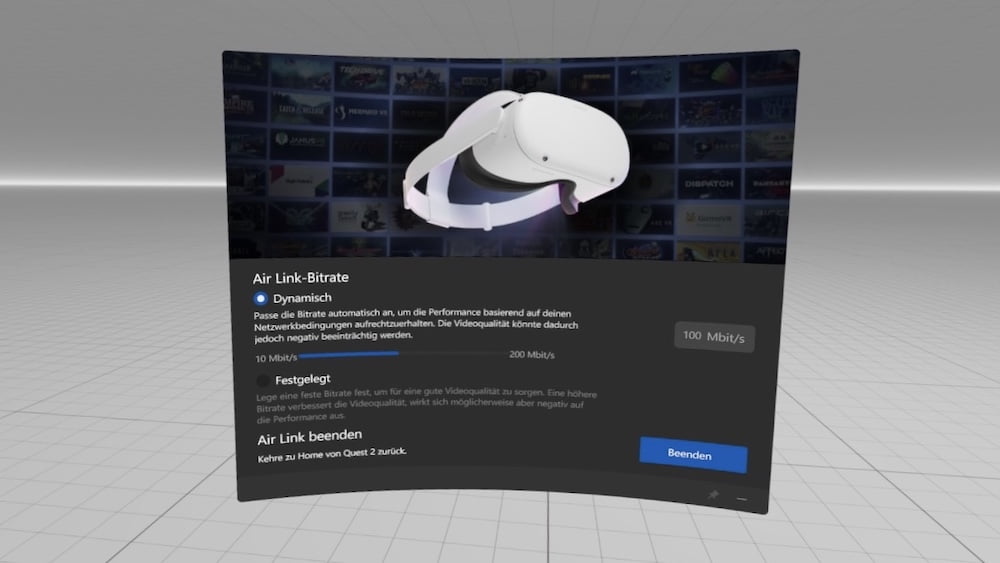Meta Quest 2: PC VR streaming with Air Link - latency review

With Air Link, you can stream PC VR games to the Quest 2 over your wifi network. How high is the latency?
The following measurements and test impressions were kindly provided by our Unreal Engine expert Robin Hasenbach.
What Air Link is and what you have to consider when setting up the wireless data transfer can be read in detail in our PC VR streaming guide. There you will also find similarities, differences, and advantages and disadvantages of the paid alternative Virtual Desktop.
We measured the Air Link performance in three test environments:
- a high-end PC with a relatively complex network setup,
- a gaming notebook with a separate access point, and
- a gaming notebook with Wi-Fi hotspot.
We streamed to a Meta Quest 2 with 64 gigabytes of storage. General test impressions follow at the end of the article.
Content
Test environment A: High-end PC
System configuration:
- GPU: RTX 3090
- CPU: AMD Ryzen 5900X
- RAM: 32GB
- SSD: M.2 NVMe
- Operating system: Windows 10 Pro (latest version)
- NVidia driver: 466.11 (Game-Ready driver)
Network:
- PC connected via Cat.7 cable
- approx. 9m to patch panel in network cabinet
- 10 cm Cat.7 patch cable from patch panel to switch
- 24-port Netgear Gigabit switch
- 5 m Cat.7 cable to Wi-Fi access point
- Ubiquiti U6-LR Wi-Fi access point (attached to wall approx. 3 m away from the Meta Quest 2)
- Total length: approx. 14m network cable + 3m wireless
Results
We came up with the following readings and a latency of 54.8 milliseconds.
- Encode/Transfer/Decode: approx. 5.6ms
- Frame Latency: approx. 54.8ms
- Frame Rate: 90Hz
- App Tracking Lead Time: ca. 29.4ms
Test environment B: Gaming notebook with access point
System configuration:
- GPU: RTX 2060
- CPU: Intel i7 8750H
- RAM: 16GB RAM
- SSD: M.2 NVMe
- Operating system Windows 10 Pro (latest version)
- NVidia driver: 466.11 (game-ready driver)
Network:
- Laptop to Wi-Fi access point (wireless, approx. 3m)
- Quest 2 to Wi-Fi Access Point (approx. 3m)
- Total length: approx. 6m Wireless
Results
We came up with the following readings and a latency of 59.1 milliseconds.
- Encode/Transfer/Decode: approx. 6.7ms
- Frame Latency: approx. 59.1ms
- Frame Rate: 80Hz
- App Tracking Lead Time: approx. 30.7ms
Test environment C: Gaming notebook with Wi-Fi hotspot.
System configuration:
- GPU: RTX 2060
- CPU: Intel i7 8750H
- RAM: 16GB RAM
- SSD: M.2 NVMe
- Operating system Windows 10 Pro (latest version)
- NVidia driver: 466.11 (game-ready driver)
Network:
- Wi-Fi hotspot open on the notebook
- Total length: approx. 3 m wireless
Results
We came up with the following readings and latency of 79.9 milliseconds.
- Encode/Transfer/Decode: approx. 3ms (strongly fluctuating!)
- Frame Latency: approx. 79.9ms (strongly fluctuating!)
- Frame Rate: 72.5Hz (Fluctuating!)
- App Tracking Lead Time: approx. 30.1ms
Conclusion
We tested Air Link with the following games:
Singleplayer:
- Half Life: Alyx
- Blade & Sorcery
- Beat Saber
- Google Earth VR
Multiplayer:
- Pavlov VR
- Population One
- Phasmophobia
The latency is not noticeable as long as you have access to a good network. The hotspot solution (test environment C) is possible, but not advisable because the latency is much higher in direct comparison. It is better to use a separate Wi-Fi access point and connect it to the PC as short as possible (test environment B). High latencies were caused by long cable routes and redirections (test environment A).
Further, the above titles can be played well as usual, and there are no differences in image quality between the wired solution Oculus Link and the native cable connection of the Oculus Rift S at first. Only in Beat Saber does Air Link become noticeable in terms of latency from the Expert level onwards.
Air Link is perfectly sufficient for non-competitive titles or slower games, so you can safely do without the Link cable in most cases in the future. For the best experience, we suggest setting the bitrate to Dynamic and 200 Mbit per second. Very high latencies can occur with a fixed bitrate, while image artifacts are occasionally visible with a low dynamic bitrate.
Note: Links to online stores in articles can be so-called affiliate links. If you buy through this link, MIXED receives a commission from the provider. For you the price does not change.